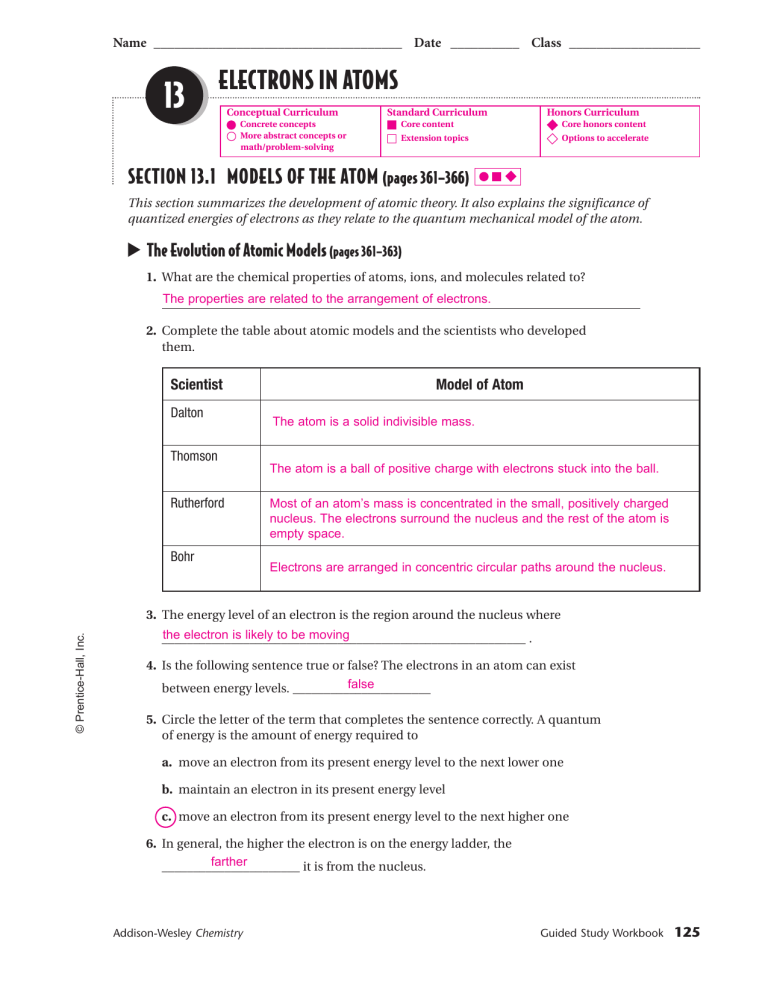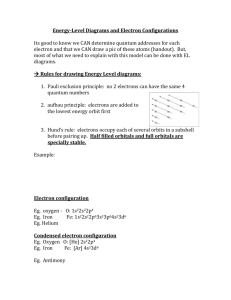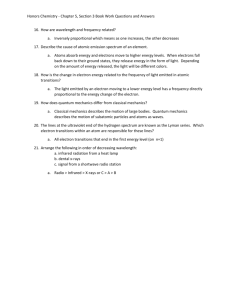13 ELECTRONS IN ATOMS
advertisement

Name ____________________________________ Date __________ Class ___________________ 13 ELECTRONS IN ATOMS Conceptual Curriculum Concrete concepts More abstract concepts or math/problem-solving Standard Curriculum Honors Curriculum Core content Core honors content Extension topics Options to accelerate SECTION 13.1 MODELS OF THE ATOM (pages 361–366) This section summarizes the development of atomic theory. It also explains the significance of quantized energies of electrons as they relate to the quantum mechanical model of the atom. The Evolution of Atomic Models (pages 361–363) 1. What are the chemical properties of atoms, ions, and molecules related to? The properties are related to the arrangement of electrons. 2. Complete the table about atomic models and the scientists who developed them. Scientist Dalton Model of Atom The atom is a solid indivisible mass. Thomson The atom is a ball of positive charge with electrons stuck into the ball. Rutherford Bohr Most of an atom’s mass is concentrated in the small, positively charged nucleus. The electrons surround the nucleus and the rest of the atom is empty space. Electrons are arranged in concentric circular paths around the nucleus. © Prentice-Hall, Inc. 3. The energy level of an electron is the region around the nucleus where the electron is likely to be moving __________________________________________________________ . 4. Is the following sentence true or false? The electrons in an atom can exist false between energy levels. ______________________ 5. Circle the letter of the term that completes the sentence correctly. A quantum of energy is the amount of energy required to a. move an electron from its present energy level to the next lower one b. maintain an electron in its present energy level c. move an electron from its present energy level to the next higher one 6. In general, the higher the electron is on the energy ladder, the farther ______________________ it is from the nucleus. Addison-Wesley Chemistry Guided Study Workbook 125 Name ____________________________________ Date __________ Class ___________________ CHAPTER 13, Electrons in Atoms (continued) The Quantum Mechanical Model (pages 363–364) 7. What is the difference between the previous models of the atom and the modern Previous models were physical models based on the quantum mechanical model? __________________________________________________ motion of large objects. The quantum mechanical model is a mathematical model. 8. Is the following sentence true or false? The quantum mechanical model of the atom estimates the probability of finding an electron in a certain position. true ______________________ Atomic Orbitals (pages 364–366) 9. Circle the letter of the term that correctly answers this question. Which name describes the major energy levels of electrons? a. atomic orbitals c. quantas b. quantum mechanical numbers d. principal quantum numbers (n) increasing 10. Principal energy levels are assigned values in order of ______________________ energy: n 1, 2, 3, 4, and so forth. 11. In the quantum mechanical model the regions where electrons are likely atomic orbitals to be found are called ______________________ and are denoted by letters ______________________ . 12. Match each diagram below with the name of its p orbital, the px , py , or pz. z z z x x y y y px py pz p orbitals 13. Use the diagram above. Describe how the px , py , and pz orbitals are similar. The p orbitals are similar because they are all dumbbell shaped. The p orbitals have different 14. Describe how the px , py , and pz orbitals are different. _____________________________ orientations in space. They are all perpendicular to each other. 15. Circle the letter of the formula for the maximum number of electrons that can occupy a principal energy level. Use n for the principal quantum number. a. 2n2 b. n2 126 Guided Reading and Study Workbook c. 2n d. n © Prentice-Hall, Inc. x Name ____________________________________ Date __________ Class ___________________ SECTION 13.2 ELECTRON ARRANGEMENT IN ATOMS (pages 367–370) This section shows you how to apply the aufbau principle, the Pauli exclusion principle, and Hund’s rule to help you write the electron configurations of elements. It also explains why the electron configurations for some elements differ from those assigned using the aufbau principle. Electron Configurations (pages 367–369) 1. The ways in which electrons are arranged around the nuclei of atoms are electron configurations called ___________________________________________ . Match the name of the rule used to find the electron configurations of atoms with the rule itself. b _______ 2. aufbau principle a. When electrons occupy orbitals of equal energy, one electron enters each orbital until all the orbitals contain one electron with parallel spins. b. Electrons enter orbitals of lowest energy first. c. An atomic orbital may describe at most two electrons. c _______ 3. Pauli exclusion principle a _______ 4. Hund’s rule 5. Look at the aufbau diagram, Figure 13.6 on page 367. Which atomic orbital 4f is of higher energy, a 4f or a 5p orbital? _______ 6. Fill in the electron configurations for the elements given in the table. Use the orbital filling diagrams to complete the table. Electron Configurations for Some Selected Elements Orbital filling Element © Prentice-Hall, Inc. H He Li C N O F 1s 2s 2px 2py 2pz 3s Electron configuration 1s 2 1s 2 1s 22s1 1s 22s 22p 2 1s 22s 22p 3 1s 2 2s 22p 4 1s 22s 22p 5 Ne 1s 22s 22p 6 Na 1s 22s 22p 63s 1 Guided Reading and Study Workbook 127 Name ____________________________________ Date __________ Class ___________________ CHAPTER 13, Electrons in Atoms (continued) 7. In the shorthand method for writing an electron configuration, what does a superscript stand for? The superscript stands for the number of electrons occupying a given sublevel. 8. In the shorthand method for writing an electron configuration, what does the sum of the superscripts equal? The sum equals the number of electrons in the atom. Exceptional Electron Configurations (page 370) 9. Is the following sentence true or false? The aufbau principle works for false every element in the periodic table. ______________________ stable 10. Filled energy sublevels are more ______________________ than partially filled sublevels. filled 11. Half-filled levels are not as stable as ______________________ levels, but are more stable than other configurations. Reading Skill Practice Outlining can help you understand and remember what you have read. Prepare an outline of Section 13.2, Electron Arrangement in Atoms. Begin your outline by copying the headings from the textbook. Under each heading, write the main idea. Then list the details that support, or back up, the main idea. Do your work on a separate sheet of paper. The subheads of students’ outlines of the section should be Electron Configurations and Exceptional Electron Configurations. The section’s main ideas should form the next level of the outline. (pages 372–383) This section explains how to calculate the wavelength, frequency, or energy of light, given two of these values. It also explains the origin of the atomic emission spectrum of an element. Light and Atomic Spectra (pages 372–375) 1. Light consists of electromagnetic waves. What kinds of visible and invisible radiation are included in the electromagnetic spectrum? The following kinds of radiation are included in the electromagnetic spectrum: radio waves, microwaves, infrared waves, visible light, ultraviolet waves, x-ray, and gamma rays. 128 Guided Reading and Study Workbook © Prentice-Hall, Inc. SECTION 13.3 PHYSICS AND THE QUANTUM MECHANICAL MODEL Name ____________________________________ Date __________ Class ___________________ 2. Match each term describing waves to its definition. b _______ amplitude a. the distance between two crests a _______ wavelength c _______ frequency b. the wave’s height from the origin to the crest c. the number of wave cycles to pass a given point per unit of time 3. Label the parts of a wave in this drawing. Label the wavelength, the amplitude, the crest, and the origin. Wavelength λ Crest Amplitude Origin 4. Is the following sentence true or false? The frequency and wavelength of all true waves are inversely related. ______________________ 5. The product of frequency and wavelength always equals a(n) constant ______________________ , the speed of light. 6. The units of frequency are usually cycles per second. The SI unit of hertz (Hz) cycles per second is called a(n) ______________________ . © Prentice-Hall, Inc. 7. When sunlight passes through a prism, the different wavelengths separate into spectrum a(n) ______________________ of colors. 8. Put the visible colors in order from light with the longest wavelength and lowest frequency to light with the shortest wavelength and the highest frequency. 3 2 _______ orange _______ yellow 4 _______ green 5 _______ blue 7 _______ violet 6 _______ indigo 1 _______ red 9. Look at Figure 13.10 on page 373. The electromagnetic spectrum consists of radiation over a broad band of wavelengths. What type of radiation has the lowest frequency? The highest frequency? Radio waves have the lowest frequency. Cosmic rays have the highest frequency. 10. What happens when an electric discharge is passed through the gas or vapor of an element? The element emits light as it is excited by the passage of the electric discharge. Guided Reading and Study Workbook 129 Name ____________________________________ Date __________ Class ___________________ CHAPTER 13, Electrons in Atoms (continued) 11. Passing the light emitted by an element through a prism gives the atomic emission spectrum _________________________________________________ of the element. 12. Is the following sentence true or false? The emission spectrum of an element can be the same as the emission spectrum of another element. false ______________________ The Quantum Concept and the Photoelectric Effect (pages 376–379) 13. Planck showed mathematically that the amount of radiant energy (E) absorbed proportional or emitted by a body is ______________________ to the frequency of the radiation: E h v. 14. What is a small, discrete unit of energy called? It is called a quantum. 15. What did Albert Einstein call the quanta of energy that is light? photons ______________________ 16. What is the photoelectric effect? The photoelectric effect occurs when metals eject electrons called photoelectrons when light shines on them. 17. Is the following sentence true or false? Albert Einstein recognized that there is a threshold value of energy below which the photoelectric effect does not true occur. ______________________ An Explanation of Atomic Spectra (pages 379–380) ground state 18. What is the lowest energy level of an electron called? ____________________________ _ lower ______________________ energy levels lose energy and emit light. Quantum Mechanics (pages 381–382) 20. What does de Broglie’s equation describe? It describes the wavelength of a moving particle. 21. What does de Broglie’s equation predict? It predicts that all matter exhibits wavelike motions. 22. Is the following sentence true or false? The new method of describing the motions of subatomic particles, atoms, and molecules is called quantum true mechanics. ______________________ 130 Guided Reading and Study Workbook © Prentice-Hall, Inc. higher 19. Only electrons in transition from ______________________ to








